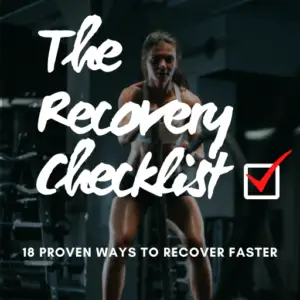Stretching out your hamstrings won’t prevent injury. But I’ll tell you what will prevent injury. The problem with stretching is that it doesn’t do what it’s supposed to do.
I heard all the stretching myths as a young athlete: That it’s mandatory to stretch before exercise. That stretching prevents injury. And that more flexibility is always better.
Later I learned that static stretching is overrated. Here’s why:
- It doesn’t prevent injury
- It hampers athletic performance
- It’s a mediocre pain-relief option (except for plantar fasciitis)
- It exacerbates problems for hypermobile folks

Stretching isn’t a great use of time unless you’re super stiff, in a flexibility-heavy sport, or dreaming of joining the circus as a contortionist.
Here are 3 superior alternatives to stretching:
1) Aerobic Exercise
Even if your t-shirt that says “sarcasm is my cardio,” you still need aerobic exercise.
Cardio reduces stress and improves sleep. Plus, it’s a natural pain-reliever that won’t make you groggy or constipated.
Aerobic exercise is one of the best treatments for TMJ and neck pain. And staying active is a proven tactic for low back pain, too.
Aim for 150 minutes of moderate cardio per week – think brisk walking, hiking, and biking. Or do vigorous cardio for 75 minutes a week – like running and circuit training.
Not a runner? I’m there with you. Here’s how to start a cardio habit with low-impact exercises.
2) Strength Training
Pumping iron has unique benefits that are unattainable by cardio alone.
Resistance training boosts metabolism and bone strength better than aerobic exercise. It builds muscle mass and strength that are vital to longevity.
And eccentric strengthening exercises increase flexibility just as much as stretching!
So grab a dumbbell, barbell, band or weight machine and get to work. Alternatively, opt for bodyweight exercises like pull-ups, push-ups, air squats and planks.
Strength training relieves pain and builds resilience. Current data suggest that strength training reduces sports injury risk by 40-70%. And it’s a key component of the best rehab programs.
Believe it or not, deadlifts are among the best exercises for low back pain. Second only to McKenzie exercises in my book.
3) Yoga
Yoga involves stretching, but it’s much more than that.
It combines deep breathing, strength work, dynamic mobility and mindfulness. Though research shows it’s typically not intense enough to qualify as “moderate intensity” cardio.
Yoga improves mental health – it’s proven effective for anxiety and depression. And the physical health benefits are obvious – enhanced flexibility, muscular endurance and strength.
To learn more about yoga and start your own practice, check out Yoga with Adriene for free on Youtube.
The Problem with Stretching
Aerobic exercise, strength training and yoga are superior alternatives to static stretching.
The biggest problem with stretching is that it doesn’t live up to the hype. It doesn’t enhance performance or prevent injury.
To make the most of stretching, save it for after your workouts. Add a dynamic component to sharpen your motor control. And stretch to achieve a functional goal – like squatting deeper or tying your shoes more easily.
And for more science-based health and wellness insights, join the free Facts & Physio Newsletter. Plus, get The Recovery Checklist when you sign up.

